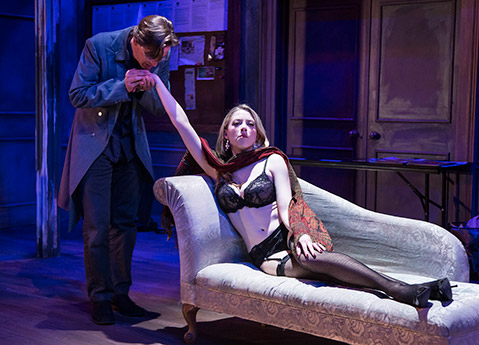ETC’s Venus in Fur
A Great Play from Top to Bottom

With his 2010 play Venus in Fur, David Ives has granted directors everywhere their fondest wish, which I imagine goes something like this: “Dear playwright, please bring me a new two-person show that’s both intelligent and funny! Make it deep enough to withstand repeated viewings, and fill it to the brim with unresolved sexual tension.” Whether or not this request was ever formulated quite so exactly, Venus in Fur nevertheless arrives as the answer to some similar prayer, as it easily fulfills all of the above conditions. Under Andrew Barnicle’s crisply energetic direction, and in a perversely gorgeous set designed by Stephen Gifford and lit by Jeremy Pivnick, actors Bruce Turk and Annie Abrams turn up the heat as the writer Thomas Novachek and Vanda Jordan, an actress auditioning for the lead in Novachek’s adaptation of Leopold von Sacher-Masoch’s novella Venus in Furs.
Although the plot mirrors that of the novella to a certain extent, and there is certainly plenty of eroticism in the play, ultimately this Venus in Fur is not particularly concerned with the nuts and bolts (or should that be knots and buttons?) of sadomasochism. As in Ives’s earlier work All in the Timing, the emphasis falls on the tension between what lines in a script might mean in the abstract versus what they mean to the person saying them.
When Vanda Jordan arrives late to the casting call to play the young dominatrix in Thomas Novachek’s play, she makes a poor first impression by cursing and reeling off clichés in a parody of contemporary girlspeak. But when she finally manages to persuade the reluctant playwright to read his script with her, she becomes a different person, handling the play-within-a-play’s Eastern European accent and sophisticated dialogue with dazzling fluency. Over the course of the evening, this ironic split between the two sides of Jordan becomes a source of great mystery, first to Novachek, and by the ending, to the audience, as well. Many of the night’s best moments came from the skill with which Abrams navigates the abrupt transitions that Ives has designed for her role.
As Thomas Novachek, Turk quickly sheds his initial reluctance to read with Jordan at all and gradually allows her to seduce him deeper into the role of Severin, Sacher-Masoch’s protagonist. Jordan’s insistence that he read Severin’s long speeches rather than skipping over them is the first clue that she is on her way to holding the upper hand in their seesawing relationship.
In addition to many clever reflections on the audition and play-development process, there’s a deeper message in Venus in Fur that trumps the various debates about sexual exploitation that Ives explores along the way. As with the coffee that gets tagged as a symbolic gesture twice during the action, the play’s ending implies that there’s something more to this meditation on theater than entertainment. Watch out for the chthonic forces that lurk beneath the proscenium, Ives seems to say, as they are the true masters.



